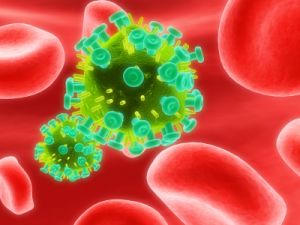 A group of doctors in Berlin have announced that they may have cured an HIV-infected man with leukemia by using stem-cell transplants. Throughout most of the industrialized world, stem-cell research has become an acceptable means of curing disease, but in the religiously fundamentalist United States fears still linger over the use of stem-cells derived from embryos, which some conservatives view as human beings with their own rights. It may be a "no-brainer" for many, and galling enough to make some progressives roll their eyes, but it is nonetheless important to ask conservatives the question, would a real Christian support stem-cell research if it saved millions of lives, or released them from the clutches of the pharmaceutical industry?
A group of doctors in Berlin have announced that they may have cured an HIV-infected man with leukemia by using stem-cell transplants. Throughout most of the industrialized world, stem-cell research has become an acceptable means of curing disease, but in the religiously fundamentalist United States fears still linger over the use of stem-cells derived from embryos, which some conservatives view as human beings with their own rights. It may be a "no-brainer" for many, and galling enough to make some progressives roll their eyes, but it is nonetheless important to ask conservatives the question, would a real Christian support stem-cell research if it saved millions of lives, or released them from the clutches of the pharmaceutical industry?
The Berlin patient, Timothy Ray Brown, underwent a stem-cell transplant using bone marrow from a donor with a genetic mutation that allows resistance to HIV infection. The mutation results in a lack of CCR5 receptors on CD4 cells, which is important since the HIV virus uses CCR5 receptors to infect CD4 immune system cells. In preparation for the transplant, Brown received total body irradiation and chemotherapy that destroyed most of the receptor-bearing CD4 cells; in addition, he received immunosuppressive therapy to prevent rejection of the HIV-resistant stem-cells. After a relapse of leukemia, Brown had to receive a second transplant; he also had to forgo antiretroviral treatment during the procedure.
The immunosuppressive treatment preventing cell rejection continued for 38 months, and colon biopsies were taken at intervals during this period to determine whether any disease had resulted from cell-grafting; immune cell samples were also taken from the gut wall to determine the presence of HIV infection. At the end of this phase of HIV/AIDS treatment and recovery, the CD4 cells bearing the dreaded, HIV-friendly receptor were undetectable, suggesting that the old CD4 cells has been destroyed by chemotherapy and replaced by the new batch of stem-cells without the receptor.
Nevertheless, doctors were unable to detect HIV, and HIV antibody levels had declined "to the point that the patient has no antibody reactivity to HIV core antibodies, and only very low levels of antibodies to the HIV envelope proteins", according to Keith Alcorn of Aidsmap.com. In addition, Brown developed a neurological condition seventeen months after the transplant which required a lumbar puncture to sample cerebrospinal fluid, as well as a brain biopsy, to for diagnostic purposes. In these samples, HIV was also undetectable.
Brown's ostensible recovery has been arduous he underwent two relapses of leukemia and two transplants. When asked by German media whether he would have rather live with HIV than undergo such a grueling procedure, he responded, "Perhaps. Perhaps it would have been better, but I don't ask those sorts of questions anymore". Dr. Gero Hütter, who was in charge of Brown's treatment, expressed optimism over the results, emphasizing the importance of changing social attitudes about AIDS/HIV recovery: "[F]or me it is important to have overthrown the dogma that HIV can never be cured. Something like this is the greatest thing one can achieve in medical research".
Whether one is supportive or critical of the use of stem-cell in fighting disease, the ultimate question is one of ethics. Although Brown's treatment did not involve embryonic stem-cells per se, many rightwing, evangelical Christians view such procedures as a slippery slope in that direction. From a virtue ethics, standpoint, conservatives might argue that no procedure which might open the door to embryonic cell-transplants in the future should be undertaken, because embryos should be treated as human beings in their own right, and each individual human being should be protected no matter how many lives his or her death might save; from a utilitarian perspective, however, progressives might argue that, first, embryos should not be considered human lives, and, second, the use of individual embryos should be undertaken because of the number of lives they might save.
Christians might want to ask themselves, what approach would Jesus Christ of Nazareth take if he were walking the earth today? Would he insist on protecting the "life" of an individual embryo even if this means leaving millions of other lives at the mercy of pharmaceutical companies, or would he insist that embryos are a precious resource for healing millions? It is ultimately a moot point, however, because the stem-cells used in Brown's recovery were not derived from embryos they were derived from the donor's bone marrow. Furthermore, doctors do not intend to use embryos for further transplant to eliminate HIV they plan on extracting them from the blood of umbilical cords. Nevertheless, the threat of taking the "lives" of embryos remains a chimera in the imaginations of conservatives.
While Brown's path to recovery should be considered carefully for its grueling nature, it should also be a source of hope and inspiration for the millions of people around the world living with HIV. It should also be considered with fairness and sound ethical reasoning by nondenominational, interfaith churches involved in ending HIV and AIDS indeed, by any church which claims to be a wellspring of compassion and altruism. Give us your thoughts. Should churches support this new medical discovery, and, if so, why do so many religions seem resistant to it?
Source:


0 comments